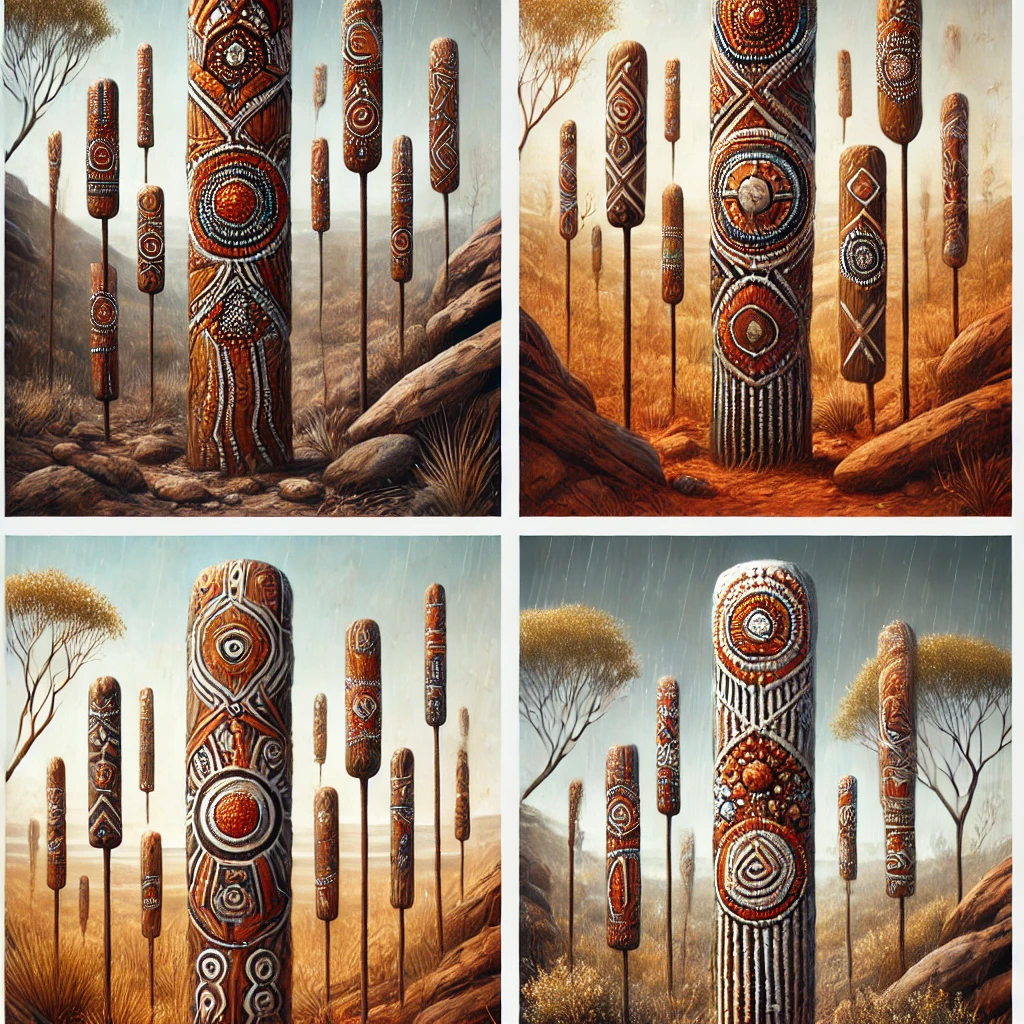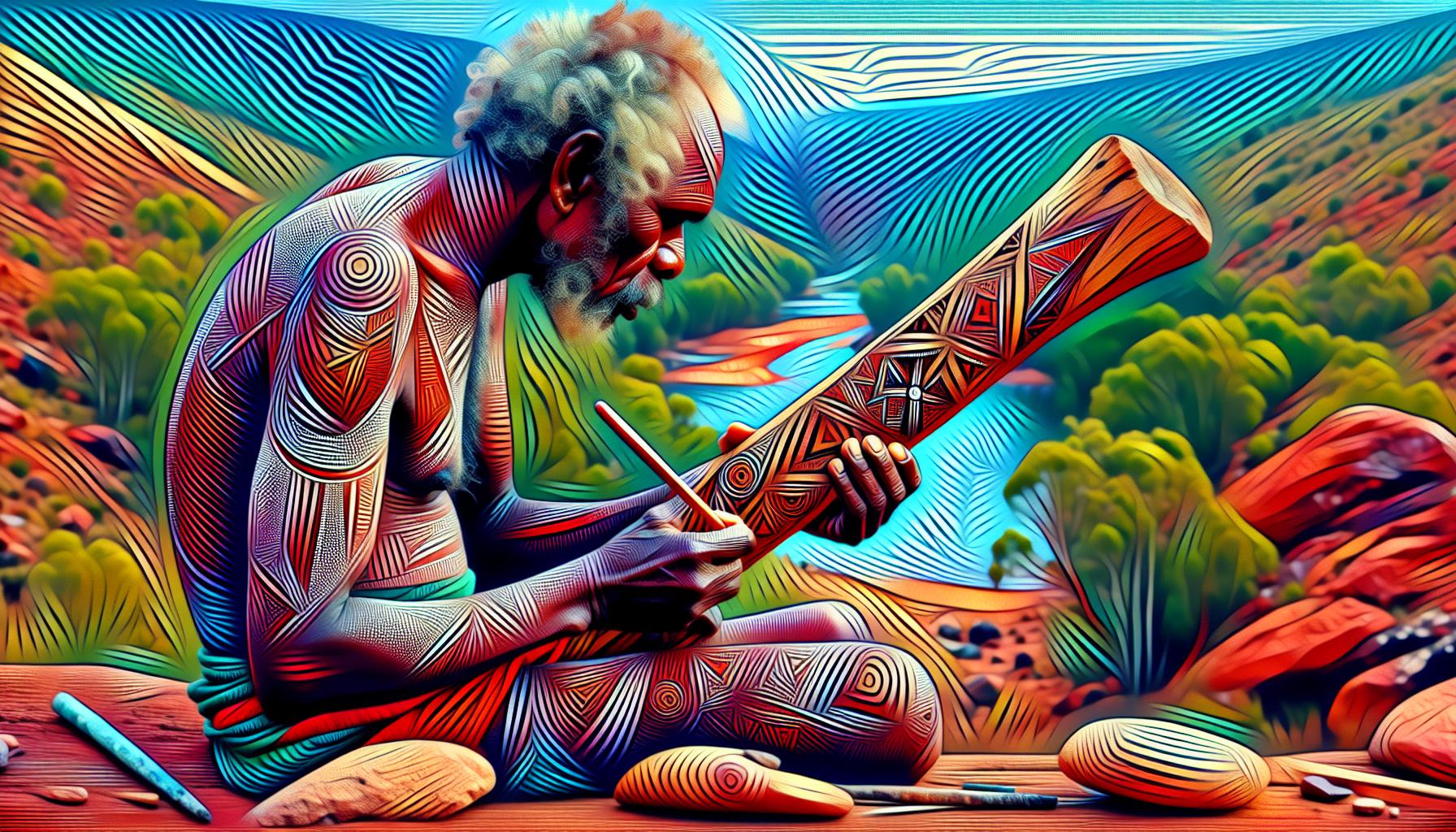I find Message Sticks to be fascinating elements of Aboriginal folklore. These unique tools served as a means of communication, allowing messages to travel across vast distances without words. By exploring their origins, we uncover the ingenuity of Indigenous Australians in preserving their stories and traditions.
Message Sticks are more than just symbols. They feature intricate designs that convey specific information and hold deep cultural significance. Delving into their use reveals the strong connections between people, land, and heritage in Aboriginal communities. Understanding Message Sticks offers a window into the rich tapestry of Aboriginal communication and storytelling.


History Of Message Sticks In Aboriginal Folklore
Definition And Purpose
Message sticks, often referred to simply as “sticks,” served as vital long-distance communication tools for Aboriginal Australians. These wooden sticks were intricately carved, incised, and painted with symbols and decorative patterns to relay specific information. Each design element held particular significance, ensuring that messages were accurately interpreted by recipients.
Historical Use
Before modern communication systems like the Overland Telegraph and Australia Post emerged, message sticks facilitated interactions between various Aboriginal nations, clans, and language groups. This method of communication was prevalent across the Australian continent, enabling the transmission of important information such as trade agreements, warnings, and ceremonial invitations. Messengers, trusted individuals within the community, would carry these sticks over vast distances to deliver messages efficiently.
Method Of Communication
Using message sticks involved a systematic process:
- Creation: A sender carved symbols into the stick, each representing different aspects of the message. These symbols included lines, circles, and other geometric shapes, each with predefined meanings within the community.
- Decoration: After carving, the sticks were painted with natural pigments. The colors and patterns added another layer of meaning, aiding in the precise delivery of the intended message.
- Transmission: Once completed, the messenger received verbal instructions to ensure accurate interpretation. The messenger then traveled to the designated location, presenting the stick to the recipient, who would decipher the symbols to understand the message.
This method ensured secure and reliable communication, preserving the integrity of messages across generations and geographical barriers.
Cultural Significance
Message sticks were more than mere communication tools; they embodied the rich cultural heritage of Aboriginal communities. The designs often reflected cultural narratives, ancestral stories, and social norms, reinforcing communal bonds and shared histories. By maintaining these traditions, Aboriginal Australians preserved their identity and facilitated the transmission of knowledge and values across generations.
Evolution Over Time
With the introduction of European technologies, the use of message sticks gradually declined. However, their historical importance remains a testament to the ingenuity and resilience of Aboriginal communication practices. Today, message sticks are valued cultural artifacts, studied for their intricate designs and the insights they provide into Aboriginal societies.
Preservation Efforts
Numerous initiatives aim to preserve message sticks and their associated knowledge. Museums and cultural centres across Australia exhibit these artifacts, educating the public about their significance. Additionally, community-led projects work to revive traditional carving techniques, ensuring that the art and purpose of message sticks continue to be honoured and understood by future generations.
Cultural Significance

Message sticks play a crucial role in Aboriginal culture, serving as vital communication tools across diverse tribes and regions.
Symbolism And Meanings
Message sticks feature intricate designs and markings that convey specific messages. Each symbol represents different information, such as ceremonial events, disputes, or invitations. The craftsmanship of these sticks ensures that the intended message is accurately interpreted by the recipient. Additionally, the designs often reflect the cultural heritage and social norms of the community, reinforcing communal identity and values.
Role In Storytelling
Message sticks facilitate the transmission of stories and traditions without spoken language. They enable the sharing of narratives across long distances, preserving oral histories and cultural knowledge. By carrying and interpreting these sticks, Aboriginal communities maintain their storytelling practices, ensuring that important tales and lessons are passed down through generations. This method of communication supports the continuity of cultural heritage and strengthens the bonds within and between communities.
Construction And Design

Materials and Size
Message sticks are crafted from durable wood, ensuring longevity. Each stick ranges from 10 to 30 centimeters (3.9 to 11.8 inches), making them portable and easy to carry[2][4].
Design and Markings
These sticks feature intricate carvings, incisions, and paintings. Symbols and decorative designs include:
- Angular lines, dots, crosses, cross-hatching, and stippling.
- Representations of people, objects, and landscapes.
Motifs vary significantly, from abstract to representational forms. They are distinctive to each group or nation, aiding in identification and authentication by neighbouring communities and translators[2][3].
Construction Process
I carve the message stick in the presence of the messenger, ensuring accuracy. The sender explains the message orally during construction, allowing for real-time adjustments and clear communication.
Usage And Purposes
Message Sticks served multiple functions within Aboriginal communities, facilitating both communication and ceremonial activities.
Communication Methods
Message Sticks enabled long-distance communication between Aboriginal nations, clans, and language groups. Messengers carried sticks carved with specific symbols that encoded the intended message. When languages differed, the symbols ensured accurate transmission of information. Each stick typically measured between 10 and 30 centimetres and featured intricate designs, including angular lines and dots, that represented words or phrases. Messengers memorised the oral message as the stick was being carved, allowing them to deliver the information effectively without relying solely on spoken language. This system supported the exchange of important information such as trade agreements, territorial boundaries, and responses to disputes.
Ceremonial Uses
In addition to communication, Message Sticks played a significant role in ceremonial contexts. They were used to convey invitations to gatherings, signal the commencement of rituals, and document ceremonial agreements between groups. The decorative patterns on the sticks often included motifs related to the specific ceremony, such as representations of spiritual beings or natural elements. By serving as both a practical tool and a ceremonial artifact, Message Sticks reinforced social bonds and cultural traditions within Aboriginal communities. Their presence in ceremonies underscored the importance of maintaining harmonious relationships and preserving cultural heritage.
Modern Interpretations
Contemporary interpretations of Message Sticks preserve and honour Aboriginal heritage. Artists incorporate traditional designs into modern artworks, showcasing the cultural significance of these symbols. Galleries across Australia exhibit Message Sticks, educating the public about their historical roles and artistic value.
Educational programs integrate Message Sticks to teach Indigenous communication methods. Schools collaborate with Aboriginal communities to provide workshops on carving and symbolism, fostering appreciation among younger generations. These initiatives ensure that traditional knowledge remains accessible and respected.
Cultural preservation projects document and replicate Message Sticks. Museums maintain collections that display authentic and recreated sticks, offering insights into their construction and usage. Digital archives feature high-resolution images and descriptions, enabling wider access to this cultural artefact.
Community events utilize Message Sticks in contemporary ceremonies. Local gatherings incorporate these symbols to signify unity and continuity, reinforcing social bonds within Aboriginal groups. By adapting traditional practices, communities maintain their identity while embracing modern contexts.
Technological advancements enhance the understanding of Message Sticks. 3D modelling and virtual reality applications allow detailed examination of carvings and symbols. These tools provide immersive experiences, enabling users to explore the intricate designs and their meanings interactively.
| Modern Applications | Description |
|---|---|
| Artistic Integration | Incorporation of traditional designs into contemporary artworks |
| Educational Programs | Workshops and collaborations in schools to teach carving and symbolism |
| Cultural Preservation | Museum collections and digital archives documenting Message Sticks |
| Community Ceremonies | Use of Message Sticks in modern ceremonies to signify unity and continuity |
| Technological Enhancements | 3D modelling and virtual reality for detailed examination and interaction |
These modern interpretations ensure that Message Sticks remain a vital part of Aboriginal culture, bridging the past with the present and ensuring their legacy endures.
Key Takeaways
- Essential Communication Tools: Message Sticks were crucial for long-distance communication among Aboriginal Australians, using intricate carvings and symbols to convey messages without words.
- Historical Significance: Before modern technologies, these sticks facilitated interactions between various nations, clans, and language groups, enabling the exchange of trade agreements, warnings, and ceremonial invitations.
- Cultural Heritage: Beyond their practical use, Message Sticks embodied rich cultural narratives and ancestral stories, reinforcing communal bonds and preserving Aboriginal identity and traditions.
- Intricate Design and Craftsmanship: Crafted from durable wood, each stick featured unique carvings and paintings that ensured accurate message interpretation and reflected the specific cultural heritage of the community.
- Modern Preservation Efforts: Today, Message Sticks are valued as cultural artefacts, with museums, educational programs, and community projects dedicated to preserving their legacy and integrating traditional designs into contemporary art.
- Continued Relevance: Technological advancements like 3D modelling and virtual reality enhance the understanding and appreciation of Message Sticks, ensuring their cultural significance endures in modern contexts.
Conclusion
Message Sticks are a remarkable testament to the ingenuity and resilience of Aboriginal cultures. They not only served as vital communication tools but also embodied deep cultural narratives that continue to inspire today.
Preserving these artefacts ensures that the rich heritage and stories of Indigenous Australians are honoured and passed down. I’m committed to supporting efforts that keep this tradition alive, celebrating the enduring legacy of Message Sticks.
Frequently Asked Questions
What are Message Sticks in Aboriginal culture?
Message Sticks are traditional communication tools used by Indigenous Australians to convey messages over long distances without spoken words. Crafted from durable wood, they feature intricate carvings and paintings that encode specific information such as trade agreements, ceremonial invitations, or responses to disputes. Each stick’s unique design reflects the cultural identity of the community, ensuring accurate transmission and interpretation of the intended message. Message Sticks are portable, typically ranging from 10 to 30 centimetres, and play a crucial role in preserving Aboriginal stories, traditions, and social bonds.
How were Message Sticks used for communication?
Message Sticks served as a sophisticated system of long-distance communication among Aboriginal Australians before modern technologies. Messengers would carry the sticks, each engraved and painted with symbols representing specific messages like trade agreements, territorial boundaries, or ceremonial invitations. The intricate designs ensured that the intended information was accurately interpreted by the recipients. This method allowed different tribes and language groups to exchange important information efficiently, reinforcing social bonds and facilitating cooperation across vast regions.
What is the significance of the designs on Message Sticks?
The designs on Message Sticks are rich with symbolic meaning, conveying specific messages related to ceremonies, disputes, or invitations. Common motifs include angular lines, dots, crosses, and representations of people and landscapes. These symbols vary among different Aboriginal groups, aiding in the identification and authentication of the messages. The intricate craftsmanship ensures clarity and accuracy in communication, while also reflecting the cultural heritage and artistic traditions of the communities that create them.
How were Message Sticks constructed and decorated?
Message Sticks are crafted from durable wood and typically measure between 10 to 30 centimetres in length, making them easy to transport. The construction process involves carving the stick with precise incisions and patterns that encode the intended message. After carving, the sticks are painted with natural pigments to highlight the symbols and decorative designs. The messenger often oversees the creation to allow real-time adjustments, ensuring the message is clearly communicated. This meticulous process guarantees that each Message Stick effectively serves its purpose in conveying accurate information.
What role did Message Sticks play in ceremonial activities?
In ceremonial contexts, Message Sticks were used to convey invitations to gatherings, signal the commencement of rituals, and document ceremonial agreements. They reinforced social bonds and cultural traditions by facilitating the exchange of important information during significant events. By using Message Sticks in ceremonies, Aboriginal communities maintained harmonious relationships and preserved their cultural heritage, ensuring that rituals and communal activities were conducted with mutual understanding and respect.
Why have the use of Message Sticks declined?
The use of Message Sticks has declined with the advent of European technologies such as telephones and electronic communication. These modern systems offer faster and more widespread means of communication, reducing the reliance on traditional methods like Message Sticks. Additionally, the transmission of knowledge and skills related to Message Stick creation has diminished over generations. However, Message Sticks remain valued as cultural artifacts, and efforts are underway to preserve and revive their traditional use and significance.
How are Message Sticks preserved today?
Today, Message Sticks are preserved through various cultural preservation projects and educational programmes. Museums maintain collections and digital archives that document their construction and usage, while community events incorporate Message Sticks in modern ceremonies to signify unity and continuity. Contemporary artists also recreate traditional designs in their works, and schools collaborate with Aboriginal communities to teach carving and symbolism. Technological advancements like 3D modelling and virtual reality further enhance the understanding and interaction with these artefacts, ensuring their legacy endures.
How do contemporary artists incorporate Message Sticks?
Contemporary artists honour traditional Message Sticks by incorporating their designs and symbolism into modern artworks. This fusion showcases the cultural significance of Message Sticks and promotes appreciation for Aboriginal heritage. Artists may recreate the intricate carvings and paintings using traditional techniques or adapt the symbols into new artistic expressions. By blending the old with the new, contemporary artists help keep the tradition alive, making Message Sticks relevant in today’s cultural landscape and ensuring their stories continue to be told.
What is the cultural importance of Message Sticks?
Message Sticks embody the rich heritage of Aboriginal communities, reflecting narratives, social norms, and communal values. They serve as vital communication tools that reinforced social bonds and facilitated cooperation among diverse tribes and regions. Through their intricate designs, Message Sticks preserve oral histories and cultural knowledge, ensuring that important stories and lessons are passed down through generations. They are also significant as cultural artefacts, representing the artistic craftsmanship and deep cultural connections of Indigenous Australians.
How do educational programmes promote Message Sticks?
Educational programmes promote Message Sticks by collaborating with Aboriginal communities to teach traditional carving and symbolism to younger generations. These programmes foster appreciation and understanding of Aboriginal culture by integrating the study of Message Sticks into school curricula. Workshops and hands-on activities allow students to engage directly with the crafting process, while digital resources and museum exhibits provide additional learning opportunities. By educating the youth, these programmes help preserve the knowledge and skills associated with Message Sticks, ensuring their continued relevance and cultural significance.
Author

Josh Morley holds a Bachelor’s degree in Theology from the Trinity School of Theology and a Diploma in Theology from the Bible College of Wales. His academic journey involved interfaith community projects and supporting international students, experiences that shaped his leadership and reflective skills. Now based in Liverpool, Josh is also the founder of Marketing the Change, a digital agency specializing in web design and marketing.
View all posts





